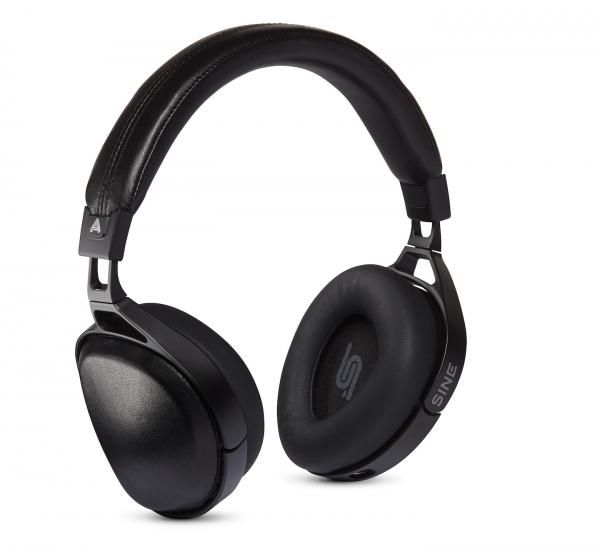Audeze Sine Planar-Magnetic Headphone Review

Over the last few years, Audeze, known for their acclaimed LCD series headphones, have expanded their lineups of entry level enthusiast-grade headphones. In 2015, they released the EL-8, a line of portable planar-magnetic over-ear headphones. This year at CES, Audeze announced the launch of not only their most affordable, but most wearable offering yet: the Sine; lightweight, closed-backed, on-ear, planar magnetic headphones. Additionally, the Sine are available with Cipher: a lightning cable with remote, mic, and, oh yeah... an integrated amp, DSP and DAC. Needless to say, I needed to get these on my noggin as soon as possible.
A far cry from the large, nearly-literal cans of their planar-magnetic heritage, the Sine hug the sides your head. Smaller than many dynamic-driver headphones I’ve seen, they are remarkably lightweight for PM driven headphones and yet feel especially substantial in your hands. With a black metal frame wrapped in black leather, the Sine look both sleek and unassuming.
Thick, linguine-style removable cables run from each earcup and, I found, tranfer very little noise when on the move. Plus, the earcups swivel so that the Sine fold flat for easy stowage in a bag or briefcase. From a design perspective, the Sine would transition easily from use at home, to commuting, to the office. And because they’re so simple and streamlined, the Sine won’t detract from any wardrobe style.
If you think I sound like a fashion magazine, it’s because the chassis of the Sine is such a far cry from their beautiful but massive planar-magnetic headphone ancestry. As much of a joy as it is to listen to Audeze’s LCD-3, you aren’t taking them with you on vacation. And while technically, you could wear the LCD-3 at work, your office had better be darn quiet and have a decent amp. So to go from something the size of a coffee can on each ear (are coffee cans even a thing anymore?) to earcups that fit in the palm of your hand is a game changer for Audeze fans.
Now that that’s out of the way, let’s talk about the sound, shall we? First, I tested out the standard cable, and, because the Sine are meant to be portable, I used my iPhone 6s to power them. The Sine have a 20 ohm impedance, and an optimal power requirement of 500mW – 1W, so I was interested to see how they fared plugged directly into my phone.
To put it mildly, I was impressed. Acoustic guitar and string instruments truly shine on the Sine. There is a clarity and smoothness to the mids and highs that I honestly didn’t expect.
Full disclosure, I found that the Sine’s predecessors, the EL-8, had a sibilant edge to their higher frequencies that sadly, often plagues enthusiast headphones at this level. As such, I was fully prepared to hear that same piercing intensity in the Sine. And yes, while there does seem to be a peak somewhere between 8-9 kHz, consonants and hi-hat sounds never reach fatiguing levels.
When listening with the standard cable powered by a mobile device, the low frequencies are somewhat recessed, although very well formed. There is no rattle or distortion in the very low (10-20 Hz) range, and although the overall sonic profile leans slightly toward the upper frequencies, there is still a solid foundation in the lower range to keep the Sine from feeling top-heavy.
That said, I wouldn’t buy the Sine for iPhone use without the Cipher. It just makes that big of a difference. Many times, when I test a portable headphone amp, the shift in quality is subtle. Perhaps because the Cipher is made specifically for the Sine, any critiques I had for the sound through the standard cable were completely rectified by the Cipher.
Though Cipher, the Sine’s low frequencies are robust and tuneful. In fact, I may go so far as to say they are the best lows I have heard in headphones under $1000. There’s a refinement to the bass, especially on already bass-heavy songs that is nimble in both attack and decay. Truly, the Sine’s separation and dexterity across all frequency ranges is enhanced through Cipher. While there is still that slight peak in the high highs, through the Cipher it really reads as sparkle and crispness rather than intensity.
While the soundstage is obviously smaller and more intimate than on open-backed headphones, the Sine through Cipher have more dimension than through the standard cable. Of course, the use of any headphone amp would enhance the sound quality of the Sine, but most other headphone amps aren’t the size of a stick of gum. That a 24-bit, high-resolution DAC/amp/DSP could be crammed into the space where the remote and mic live on a cable and somehow still make a clearly discernable improvement in sound is amazing, and the kind of thing that makes me glad I live in the future.
Really, the only criticism I have of the Sine was the clamping force. To be fair, my ears stick out somewhat, so on-ears generally aren’t a style that I can wear for long periods of time. But the headband itself was also a bit tight. As I have a smaller hat size, I could imagine folks with larger craniums might find the Sine pinch after an hour or so. But this is a minor quibble that may diminish with use. I simply haven’t had the Sine long enough to test that aspect out.
Overall, the Sine are fantastic, especially with Cipher. If you are an audio fan who wants a high quality listening experience on the go without the bulk of an amp, you can’t go wrong with this dynamic duo.
The Sine will ship in April for $449 with standard cable and $499 with Cipher. More info at www.audeze.com.
The Sine will ship in April for $449 with standard cable and $499 with Cipher. More info at www.audeze.com.





























































